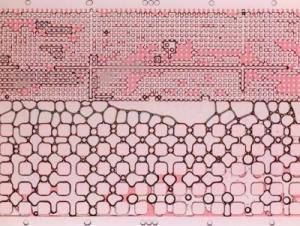Aug 13 2014
A Rice University laboratory has provided proof that foam may be the right stuff to maximize enhanced oil recovery (EOR).
 Foam sent through a microfluidic model created at Rice University shows its ability to remove oil (pink) from low-permeability formations. Rice scientists conducted experiments to see how foam would compare with water, gas or combinations of the two for use in enhanced oil recovery. Credit: Biswal Lab/Rice University
Foam sent through a microfluidic model created at Rice University shows its ability to remove oil (pink) from low-permeability formations. Rice scientists conducted experiments to see how foam would compare with water, gas or combinations of the two for use in enhanced oil recovery. Credit: Biswal Lab/Rice University
In tests, foam pumped into an experimental rig that mimicked the flow paths deep underground proved better at removing oil from formations with low permeability than common techniques involving water, gas, surfactants or combinations of the three.
The open-access paper led by Rice scientists Sibani Lisa Biswal and George Hirasaki was published online today by the Royal Society of Chemistry journal Lab on a Chip.
Oil rarely sits in a pool underground waiting to be pumped out to energy-hungry surface dwellers. Often, it lives in formations of rock and sand and hides in small cracks and crevices that have proved devilishly difficult to tap. Drillers pump various substances downhole to loosen and either push or carry oil to the surface.
Biswal's lab has learned a great deal about how foam forms. Now, with an eye toward EOR, she and her colleagues created microfluidic models of formations -- they look something like children's ant farms -- to see how well foam stacks up against other materials in removing as much oil as possible.
The formations are not much bigger than a postage stamp and include wide channels, large cracks and small cracks. By pushing various fluids, including foam, into test formations, the researchers can visualize the ways by which foam is able to remove oil from hard-to-reach places. They can also measure the fluid's pressure gradient to see how it changes as it navigates the landscape.
The team determined the numbers are strongly in foam's favor. Foam dislodged all but 25.1 percent of oil from low-permeability regions after four minutes of pushing it through a test rig, versus 53 percent for water and gas and 98.3 percent for water flooding; this demonstrated efficient use of injected fluid with foam to recover oil.
The less-viscous fluids appear to displace oil in high-permeability regions while blowing right by the smaller cracks that retain their treasure. But foam offers mobility control, which means a higher resistance to flow near large pores.
"The foam's lamellae (the borders between individual bubbles) add extra resistance to the flow," said Biswal, an associate professor of chemical and biomolecular engineering. "Water and gas don't have that ability, so it's easy for them to find paths of least resistance and move straight through. Because foam acts like a more viscous fluid, it's better able to plug high-permeable regions and penetrate into less-permeable regions."
Charles Conn, a Rice graduate student and lead author of the paper, said foam tends to dry out as it progresses through the model. "The bubbles don't actually break. It's more that the liquid drains away and leaves them behind," he said.
Drying has two effects: It slows the progress of the foam even further and allows surfactant from the lamellae to drain into low-permeability zones, where it forces oil out. Foam may also cut the sheer amount of material that may have to be sent downhole.
One of the challenges will always be to get the foam to the underground formation intact. "It's nice to know that foam can do these things, but if you can't generate foam in the reservoir, then it's not going to be useful," Conn said. "If you lose the foam, it collapses into slugs of gas and liquid. You really want foam that can regenerate as it moves through the pores."